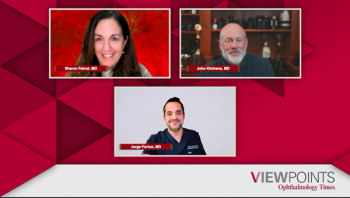
Cataract and refractive surgery: Trends, challenges, and innovations
Surgeons weigh in on emerging surgical technologies, premium lens trends, and strategies to optimize patient satisfaction and safety.
Cataract and refractive surgery continues to evolve at a rapid pace, driven by advances in intraocular lenses (IOLs), laser technology, and surgical techniques. The Eye Care Network caught up with leading members of the ophthalmology community to discuss timely topics in this field. This mini-roundtable explores how trends in premium IOLs are shaping patient outcomes and satisfaction, how femtosecond lasers and other device innovations are changing surgical workflows, which complications remain most challenging despite technological advances, and strategies for counseling patients on refractive outcomes when combining cataract and refractive procedures.
The conversation included these specialists in cataract and refractive surgery:
- Eric D. Donnenfeld, MD, clinical professor of ophthalmology at New York University Medical Center, New York, NY, and cornea, laser cataract, and refractive surgeon with Ophthalmic Consultants of Long Island.
- Omar R. Shakir, MD, MBA, medical director, Coastal Eye Surgeons in Greenwich, CT.
The Q&A begins with the impact of premium IOLs on patient outcomes and satisfaction, a topic that continues to shape decision-making in cataract and refractive surgery.
Note: Transcript edited light for clarity and length.
How have trends in premium IOLs influenced patient outcomes and satisfaction?
Donnenfeld: The major trend in premiums has been increased quality vision with new, more advanced technologies. The increase in quality of vision has improved patient satisfaction, and has significantly reduced the number of unhappy patients. This has been a driving force behind in increasing adoption of both trifocal extended depth of focus and toric IOLs.
Shakir: The move from first-generation multifocals to modern extended depth of focus (EDOF), hybrid-multifocal, and aberration-reduced optics has tightened the gap between spectacle independence and visual quality. Patients now experience smoother defocus curves, better intermediate acuity, and a lower dysphotopsia rate, especially when optics are matched to corneal SA and pupil dynamics. Layering this with advanced biometry devices (with SS-OCT, total K, chord μ) and contemporary formulas has reduced refractive surprise and lifted overall patient satisfaction. The biggest driver isn’t only the lens; it’s expectation alignment plus precise surgery that delivers the refraction the surgeon targeted.
How have femtosecond lasers and other device innovations changed your workflow?
Donnenfeld: I have been a strong proponent of the femtosecond laser for many years. The advantages of a perfect capsulorhexis that overlays the IOL in a symmetric manner improves quality vision, especially with presbyopic IOLs. In addition, small astigmatic incisions, improve, cylinder results and the chopping of the crystalline lens reduces phaco time. I have a second ophthalmologist performing my femtosecond lasers which has improved patient flow and or time.
Shakir: Femtosecond capsulotomy, lens fragmentation, and arcuates have made outcomes more repeatable and astigmatism control more predictable.
In practice:
- Shortened effective phaco time, less endothelial stress, cleaner capsulotomies for IOL centration
- On-table personalization: digital marking for precise toric alignment
- 3D digital microscopy with iOCT improves visualization, ergonomics, and involving the OR staff
Net effect: a more standardized premium pathway—fewer variables, faster recovery, and tighter refractive dispersion.
Which complications remain most challenging despite surgical advances?
Donnenfeld: Despite remarkable improvements in surgical technology, the rate limiting step for quality vision in many patients remains ocular surface disease, and dry eye. There have been major advances in this area, but it still remains a significant problem.
Shakir: Dysphotopsias (positive/negative) after diffractive or edge-sensitive optics—usually rare but emotionally loud.
Residual refractive error in post-refractive and irregular corneas; even perfect surgery can miss the target if biometry inputs are imperfect.
Ocular surface disease sabotaging quality of vision; it turns a 20/20 eye into a 20/unhappy.
IOL centration/tilt in zonular laxity or large angle kappa, and rotational stability for high-power torics.
PCO in perfectionists—not dangerous, but any drop in crispness erodes confidence until YAG restores it.
How do you counsel patients on refractive outcomes when combining cataract and refractive procedures?
Donnenfeld: When I combine cataract and refractive procedures, I council patients that there is a greater risk of the need for enhancements following their primary surgery to optimize their vision. Most patients readily understand this and are happy that adjustments can be made to the vision following surgery. Technologies, like the light adjustable lens Have significantly reduced the need for enhancements in many patients.
Shakir: Define the goal plainly: "We’re aiming for zero prescription but it doesn't necessarily always mean perfect vision. It will be very good vision and you won't need glasses for most things."
Explain the ladder of optimization: premium IOL → femto/toric/arcuates → postop refinement (IOL rotation/exchange if needed, LAL treatments). “We’re committing to your end result, not just the day of surgery.”
Quantify probabilities and trade-offs: ~90% land within ±0.50 D. "If you’re in the few percent outside that window, we'll do our best to fix it.” Discuss halos/contrast candidly and match lens to personality/visual tasks.
Set a rescue plan and timeline: surface optimization first, refraction at stability, then enhancement if warranted. Patients relax when they know there’s a clear pathway.
Eric D. Donnenfeld, MD
E: [email protected]
Donnenfeld is clinical professor of ophthalmology at New York University Medical Center, New York, NY, and cornea, laser cataract, and refractive surgeon with Ophthalmic Consultants of Long Island. Donnenfeld did not declare any relevant disclosures.
Omar R. Shakir, MD, MBA
E: [email protected]
Shakir is medical director, Coastal Eye Surgeons in Greenwich, CT. Shakir is a consultant to Alcon, Bausch and Lomb, BVI, Topcon, and Zeiss.
Newsletter
Don’t miss out—get Ophthalmology Times updates on the latest clinical advancements and expert interviews, straight to your inbox.














































.png)


